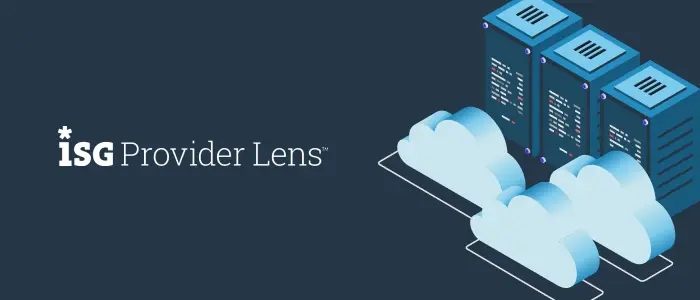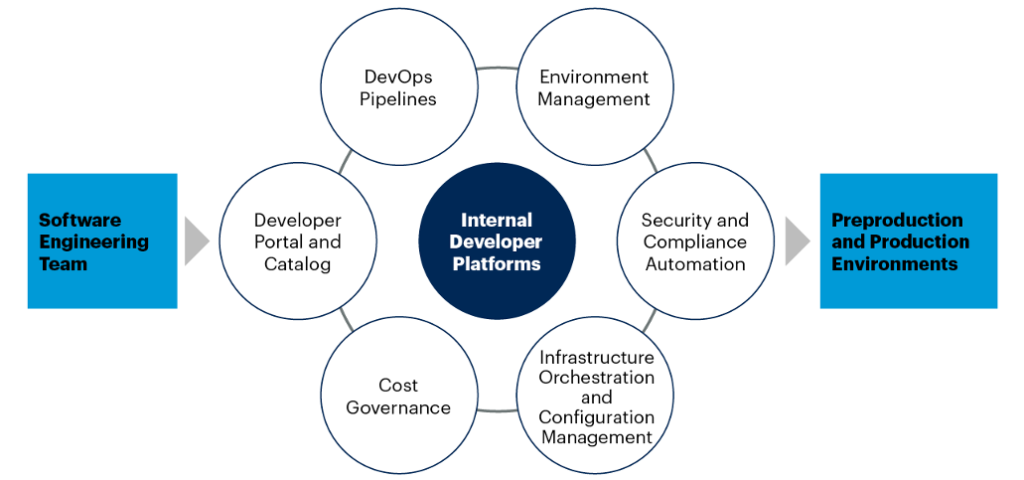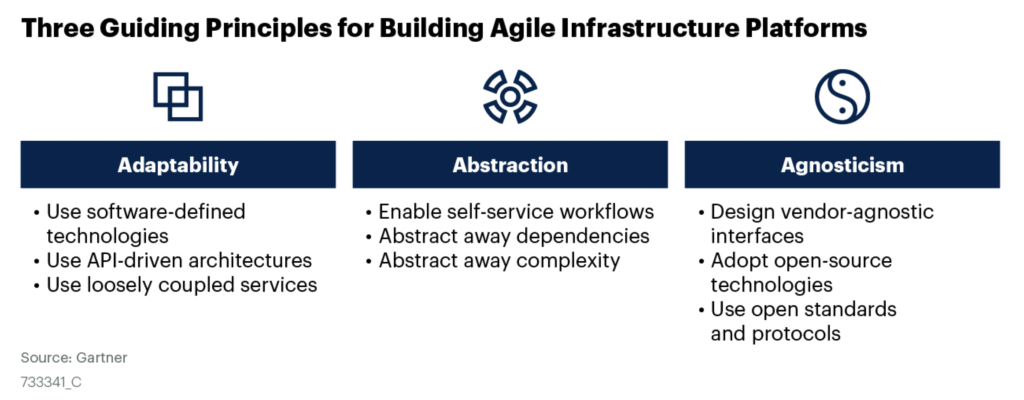
Platform engineering defined
We can start with this simple definition: Platform engineering is the practice of building and operating a common platform for internal product development teams to share and use for accelerating software releases.
In practice, different teams in different organizations can have a slightly different view of platform engineering ‘ both as to what it is and how it’s used. But a common theme emerges: Platform engineering bridges the gap between software and hardware (i.e. between Dev and Ops) ‘ and platform engineers enable application developers to release more software innovation in less time with greater efficiency.[1]
Why self-service is so important in platform engineering and hybrid cloud
Self-service is not only a hallmark in DevOps maturity, it’s also a key platform engineering attribute in that it readily supports developer-driven provisioning of both applications and the underlying infrastructure.
Today, different application developer teams working primarily in hybrid cloud and multi-cloud environments require different workflows, tools, and skillsets across different clouds and platforms, leading to massive complexity. These needs create challenges that shine a spotlight on the growing demand for a unified approach to platform engineering and developer self-service.
According to Gartner, organizations often struggle to scale DevOps initiatives. In fact, by 2023, 90% of enterprises will fail to scale DevOps initiatives if shared self-service platform approaches are not adopted. To drive long-term DevOps success, Gartner recommends that infrastructure and operations leaders should not only consider appointing platform owners and establishing platform engineering teams but also build in self-service infrastructure capabilities that align with developer needs and enable rapid delivery of customer value.[2]
Gartner also sees a continued acceleration of the trend toward self-service, recently noting that by 2025, 75% of organizations with platform teams will provide self-service developer portals to improve the developer experience and accelerate product innovation.[3]
The platform engineering team at work (and how it differs from DevOps)
From Gartner’s point of view, establishing dedicated platform teams by recruiting diversified subject-matter experts helps promote agility and responsiveness to product teams.[4] A platform engineering team should be empowered to innovate and have flexibility on how applications are deployed and operated in production to give a competitive advantage to the technology teams that consume the platform.
In the ideal scenario, the platform engineering team is constantly experimenting with and learning new practices, technologies, and tools. They work closely with the teams they support to implement and provide new features and improvements. Consider this succinct breakdown of the responsibilities of a typical platform engineering team:
Keep in mind that there’s a clear distinction between DevOps and platform engineering teams: If a team within an organization wants to host a new website, coordination between this team and a DevOps team is necessary but could exist in isolation. In contrast, platform engineers build systems that other teams can build from and operate at scale. Put a slightly different way, the role of an API boundary is a key difference between platform engineering and DevOps teams. Yes, DevOps and platform engineering teams are both concerned with deployments, service accounts, and infrastructure. The big distinction is that platform engineering teams build centralized self-service platforms offering explicit APIs and abstractions that offer flexibility for application developers across multiple project and product teams within distributed organizations.[6]

The compelling benefits of platform engineering
Platform engineering teams apply software engineering principles to accelerate software delivery, thus ensuring application development teams are productive in all aspects of the software delivery lifecycle. By constantly examining the entire software development lifecycle from source code to test and development, to provisioning and production operations, they are able to build processes and platforms that enable application developers to rapidly provision and release software.[7]
Platform engineering also reduces time to market and complexity by providing self-service provisioning for infrastructure and applications while also simplifying operations of those applications in production. The team building and operating the common platform constantly innovates and provides best practices implementation, tools, and automation.[8]
Opening the platform engineering (Pandora’s) toolbox
Platform engineering teams use infrastructure automation and configuration management tools like Ansible, Chef, or Puppet to enable continuous automation that extends processes used in software development to infrastructure engineering. The right infrastructure automation tools enable infrastructure and operations leaders to, as Gartner notes, use a continuous delivery pipeline to deploy infrastructure rapidly and safely, which in turn works to improve business agility and reliability.[9]
Infrastructure as code (IaC) tools have played a key role in elevating the growth of platform engineering and platform engineering teams. One key attribute is the ability to be checked into version control. Version control platforms, like GitHub, provide context for system infrastructure by facilitating and keeping records of changes. Hashicorp Terraform is a popular IaC framework because of its large open source community of contributors and broad support of cloud endpoints.
Legacy applications still make up over 70% of what is deployed globally and most of those are provisioned on-premises in customer datacenters. Organizations face challenges managing older VMware-based applications while also replatforming to cloud-native applications running containers or cloud-based PaaS services. Trying to maintain efficiency when bouncing between vCenter, Kubernetes platforms like OpenShift, and a variety of public cloud portals is unsustainable.
Unfortunately, like many toolboxes, organizations with a heterogeneous mix of hypervisors, clouds, operating systems, and other technologies can end up never being able to find the right size wrench at the right time. The larger and more fragmented an organization, the worse things get with different teams operating in silos. Choosing an orchestration platform from the same vendor that provides your hypervisor, cloud, or container platform opens up questions about competing interests. To get around this issue, many platform teams have tried to build home-grown self-service frameworks but ultimately they become brittle, hard to maintain, and expensive to operate.
Enter Morpheus ‘ a unified platform engineered for platform engineering
From Gartner’s perspective, as cloud adoption and agile initiatives accelerate digital transformation, organizations need infrastructure that can adapt to the rapid pace of change. Infrastructure and operations leaders should build infrastructure platforms by applying three guiding principles: adaptability, abstraction, and agnosticism.[10]

It’s at the confluence of these principles where the value of Morpheus comes so clearly into play ‘ and where hybrid cloud management platforms need to evolve. Morpheus has been categorized as a hybrid cloud management platform (CMP) and in fact is a leader in this space according to analysts like Gartner, Forrester, ISG, and Gigaom. Morpheus is proven to help companies reduce cloud cost by 30%, provision 150x faster, assure governance, and deploy hybrid cloud automation in record time.
Moving beyond CMP, let’s take another look at that platform engineer toolbox. Instead of manually cobbling together the proper set of tools, Morpheus is a unified platform developed to bring those technologies together, so no more cobbling is needed.
On the simplest level, platform engineering teams are chartered to expose self-service. This requires not only the right tools but also team members who have the right skills ‘ many of which are in short supply today. Gartner addresses this skills gap directly, noting that by 2025, only 50% of enterprises will develop skills for infrastructure automation across hybrid and multi-cloud platforms, up from less than 10% in 2021.[11]
This is where Morpheus comes in and goes beyond traditional cloud management. We help these newly burgeoning platform engineering teams fulfill their mission by simplifying how they pull all these tools and clouds together for self-service access:
What’s more, our out-of-the-box approach to self-service directly supports those three guiding principles identified by Gartner: adaptability, abstraction, and agnosticism.
[1] The Rise of Platform Engineering; Software Engineering Daily; February 2020; https://www.getambassador.io/resources/rise-of-cloud-native-engineering-organizations/
[2] Gartner; How to Scale DevOps by Building Platform Teams; Refreshed 23 September 2020, Published 8 April 2019; ID G00382537 archived
[3] Gartner; Predicts 2022: Modernizing Software Development is Key to Digital Transformation; Published 3 December 2021; ID G00758298
[4] Gartner; How to Scale DevOps by Building Platform Teams; Refreshed 23 September 2020, Published 8 April 2019; ID G00382537 archived
[5] Platform Engineering: Using it to Gain Competitive Advantage; Adarsh Shah; CompuZest; https://shahadarsh.com/2020/10/12/platform-engineering/
[6] The Rise of Platform Engineering; Software Engineering Daily; February 2020; https://softwareengineeringdaily.com/2020/02/13/setting-the-stage-for-platform-engineering/
[7] SRE vs. Platform Engineering; DevOps, GitOps, and the Rise of Cloud-Native Engineering; https://www.getambassador.io/resources/rise-of-cloud-native-engineering-organizations/
[8] Platform Engineering: Using it to Gain Competitive Advantage; Adarsh Shah; CompuZest; https://shahadarsh.com/2020/10/12/platform-engineering/
[9] Innovation Insight for Continuous Infrastructure Automation; Gartner; Published 27 April 2021; ID G00744529
[10] Gartner; How to Build Agile Infrastructure Platforms That Enable Rapid Product Innovation; Published 7 December 2020; ID G00733341
[11] Gartner; Predicts 2022: Driving Toward Digital Infrastructure Platforms; Published 21 October 2021; ID G00757487